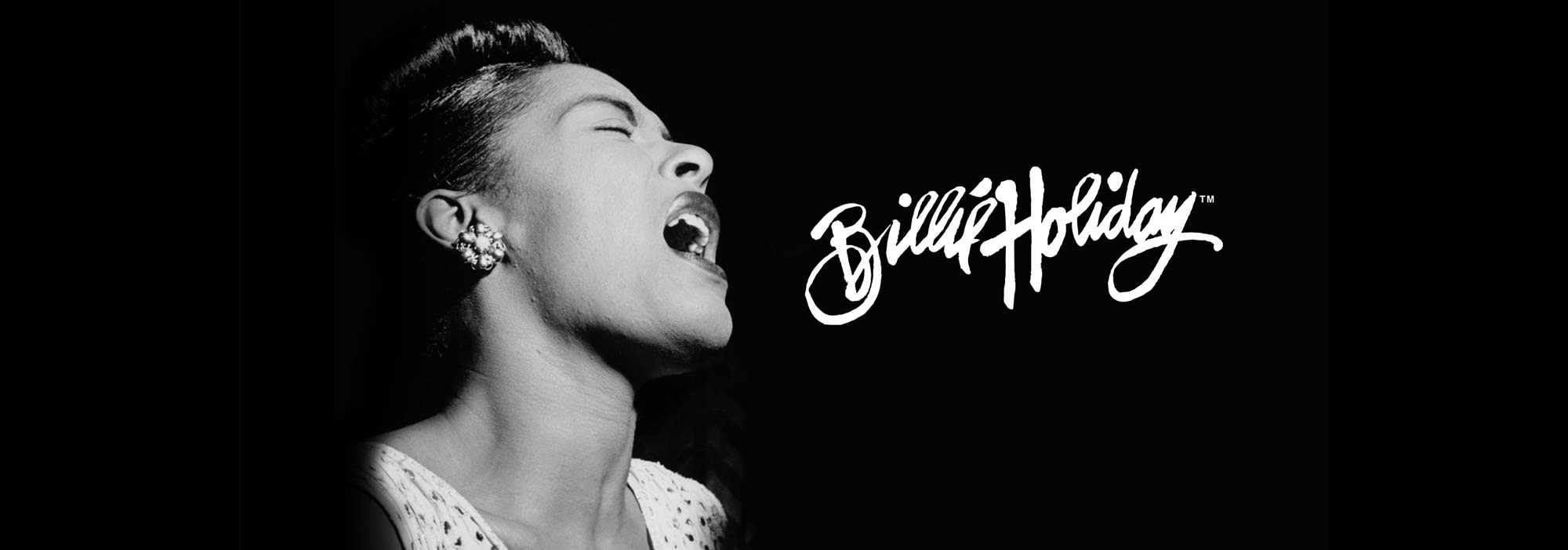
- Billie's Story -
Billie Holiday, born April 7, 1915 in Philadelphia, Pennsylvania, was a superstar of her day. She first rose to prominence in the 1930's with a unique style that reinvented the conventions of modern singing and performance. More than 80 years after making her first recording Billie's legacy continues to embody what is elegant and cool in contemporary music. Holiday's complicated life and her genre-defining autobiography “Lady Sings the Blues” made her a cultural icon. The evocative, soulful voice which she boldly put forth as a force for good, turned any song she sang into her own. Today, Billie Holiday is remembered for her musical masterpieces, her songwriting skills, creativity and courageous views on inequality and justice.
Holiday (born Eleanora Fagan Gough) grew up in jazz-soaked Baltimore of the 1920s. In her early teens, the beginning part of her “apprenticeship” was spent singing along with the records of iconoclasts Bessie Smith and Louis Armstrong. In 1929 Billie's mother Sadie Fagan moved to New York in search of better jobs. Young Eleanora soon joined her there and began showing up at jazz clubs to audition and sing with resident pianists. She made debuts in obscure Harlem nightclubs, sharing tips with other dancers and comedians on the bill. Around this time she borrowed her professional name Billie Holiday from screen actress Billie Dove. Although she never received technical training and never learned how to read music, Holiday quickly became an active participant in what was then the most vibrant jazz scene in the country – as the Harlem Renaissance transitioned into the Swing Era.
At age 18, after gathering more life experience than most adults, Holiday was spotted by producer John Hammond with whom she cut her first record as part of a studio group led by clarinetist Benny Goodman – then on the verge of his own superstardom. From 1935 to 1941 Holiday’s career accelerated, recording hit after hit with pianist/arranger Teddy Wilson. Simultaneously, in 1936 she began a legendary string of collaborations with tenor sax giant Lester Young, who's complimentary tone was a perfect trading partner for Billie. They became the best of friends and inseparable, legendary musical partners, even living together with Billie's mother for a time. Lester would famously christen her "Lady Day" as she would him "The Prez". By the time Holiday joined Kansas City's phenomenal Count Basie Orchestra for tours in 1937 she was an unstoppable force, suited for top billing across the United States. In 1938 Artie Shaw invited her to front his Orchestra, making Billie the first black women to work with a white band – an impressive and courageous accomplishment.
In the 1930's, during her epic run at Barney Josephson's Cafe Society in Manhattan, she was introduced to the poem “Strange Fruit,” a horrific depiction of lynching in the Southern United States. The music was written just for Billie and it became the hallmark of her concerts. It's considered by scholars to be the first protest song of the civil rights era. The lyric was so controversial that her record label wouldn't record it. So she jumped over to the independent Commodore Records where she could record and sing as she pleased. “Strange Fruit” immediately became a cultural spark-point and a hit record too.
In 1939, with Arthur Herzog, Jr., she wrote "God Bless The Child", a composition that transcends the ages and is now part of the great American songbook and jazz lexicon. In 1944 she signed with prestigious Decca Records, cutting still more classics and even a couple duets with her first musical hero Louis Armstrong – with whom she'd later star in the Hollywood film "New Orleans" (1949).
Starting in 1952 Billie began a five year run with Norman Granz' Clef/Verve label. Granz was the entrepreneur behind the "Jazz At The Philharmonic" series and he was very sensitive to the needs of artists. He put Billie back into small group settings from which her genius had originally grown. Together they made roughly 100 new recordings, constituting Billie's first forays into the high-fidelity album era. Her voice became more rugged and shockingly intimate. She put this new signature sound on scores of stirring ballads such as her self-reflecting composition "Lady Sings The Blues". During this period she expanded her repertoire while also re-recording many of her 1930's classics in her new style. Redefining herself as the "Torch Singer", she appeared twice on TV's "Tonight Show with Steve Allen", on CBS's historic "The Sound Of Jazz" program and also toured Europe.
In 1958, she signed to Columbia Records, the longtime home base of A&R man John Hammond, who had been instrumental in her early career. For Columbia she created her swan song masterpiece album "Lady In Satin". Final studio recordings were made for MGM in March 1959 and were released posthumously.
Billie Holiday, died at the age of 44 and is buried at Saint Raymond’s Cemetery in Bronx County, NY. Her music and life continue to inspire tributes. Whether it's Nina Simone covering "Strange Fruit"; Diana Ross starring as Lady Day in the film "Lady Sings the Blues"; U2 penning their hit "Angel Of Harlem"; her image on a United States postage stamp; Time Magazine's "Song Of The Century" Award; scores of biographies and a dozen Grammy Awards, her emotive voice, innovative technique and touching songs will forever be a hallmark of genius.
Despite her lack of technical training, Holiday’s uncanny syncopations, her inimitable phrasing and her dramatic intensity made her the outstanding jazz singer of her day. White gardenias, worn in her hair, were her trademark.
Ever combining her typical humor with profound gravitas, she wrote in her autobiography, “Singing songs like the ‘The Man I Love’ or ‘Porgy’ is no more work than sitting down and eating Chinese roast duck, and I love roast duck. I’ve lived songs like that.”
